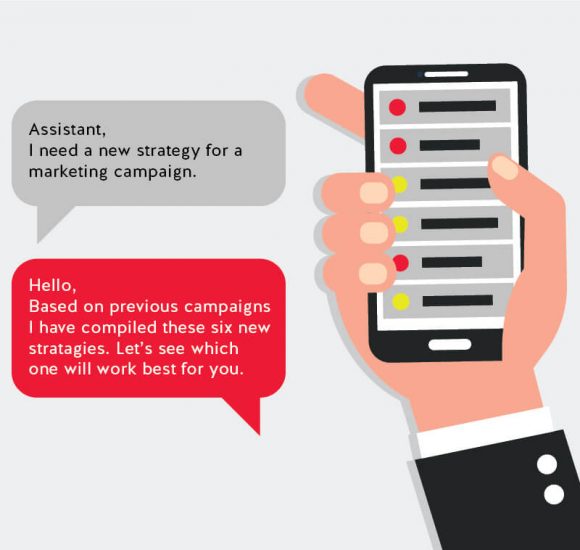AI is here to take your job! This oft-repeated mantra is used to grab a few headlines, but for now the reality is quite different. The true power of AI is in how we learn to work with these tools to better perform our jobs; thus, AI is here to augment our current abilities and not replace us.
Working Together with Machines

Machine Learning-based AI is an immensely powerful tool that is driving the next revolution in digital marketing. In a report that researched 1,500 companies, the Harvard Business Review found that, “firms achieve the most significant performance improvements when humans and machines work together.” (Collaborative Intelligence: Humans and AI Are Joining Forces).
Improving Through Machine Learning with Existing Data
Data is increasing at an exponential rate. Consider this staggering statistic, reported by Forbes: “Over the last two years alone, 90 percent of the data in the world was generated.” The obvious questions then become, “Where is all this data coming from?” and, “What can we do with it all?”
[Tweet “90% of the data in the world was generated in the last two years. Learn how AI can help us deal with it!”]
In the world of SEO, we generate a lot of data through crawls of large websites. Tools like Botify, DeepCrawl, and Perficient Digital’s own proprietary SEOCrawltm tool can generate datasets with tens of millions of URLs, including basic SEO data like titles and H1s. Don’t even think about trying to open a file like that in Excel!
Even database tools like MySQL are quickly brought to their knees with this size dataset. Big data platforms like Casandra or Hadoop are required just to begin analysis.
What if we want more? What if we could take tens of millions of webpage records and associate them with rank and traffic data at a massive scale? How could we possibly analyze this type of data in a meaningful way? One answer is to use Machine Learning-based Artificial Intelligence tools.
Is This a Magic Bullet or Does it Take Work?
Yes, with ML and AI we’ve created a magic bullet! Okay that’s tongue in cheek, so let me clarify a bit.
There is work involved and it does take some developer talent to make the magic happen, but the basic structure is fairly simple. We can apply what’s called “unsupervised machine learning.” With this type of machine learning, we’re able to give an algorithm our data sets without any human-generated labels or “training data,” and that algorithm is able to give us back meaningful information.
For example, Google uses a form of unsupervised machine learning to provide results in Google News. Google sorts through an enormous number of potential news articles to classify, categorize and finally rank them. This includes identifying the hottest story topics, and then finding all the publishers that have created content on those topics.
All of this is done without human input. This is made possible, in part, through unsupervised machine learning. You’ll notice on the bottom of the Google News results page: “The selection and placement of stories on this page were determined automatically by a computer program. The time or date displayed reflects when an article was added to or updated in Google News.”
[Tweet “Unsupervised machine learning makes it possible to generate almost-instant applications from massive real-time data. Learn more at”]
Learn more!
- If you’d like to dive deeper into document classification using ML, check out this blog post from Google Cloud.
- For more on using machine learning and AI, read this interview series with Eric Enge and Chris Penn or watch the videos!
Case Studies Using AI in the Real World
AI is currently being used to improve the way a wide range of industries do business. For example, in this case study, Modern Marketing Concepts (MMC) used an AI tool called RapidMiner to quickly improve productivity. The drag and drop modeling interface allowed the team to use it productively within days. In this example, MMC used the AI tool to create predictive models, which helped them roll out better sales and marketing campaigns for their clients.
Other Uses for ML/AI in the Real World

AI agents such as Microsoft’s Cortana can do useful things for businesses, right out of the box. For example, Cortana can transcribe meetings and automatically distribute notes. Amazon’s AWS cloud service offers meeting transcription tools, and there’s an Amazon Alexa Skill called EchoScribe to help with meeting transcriptions as well. As of this writing, it doesn’t appear that the Google Assistant is capable of handling the more complex requirements of meeting transcription. However, with Google Duplex on the horizon, anything is possible.
There are other commercially available AI tools as well. Companies like domo.com have options—here’s a list of over 50 AI-powered marketing tools.

Custom AI agents can also be trained to do things like help with customer service.
For example:
SEB, a major Swedish bank, now uses a virtual assistant called Aida to interact with millions of customers. Able to handle natural-language conversations, Aida has access to vast stores of data and can answer many frequently asked questions, such as how to open an account or make cross-border payments. She can also ask callers follow-up questions to solve their problems, and she’s able to analyze a caller’s tone of voice (frustrated versus appreciative, for instance) and use that information to provide better service later. Whenever the system can’t resolve an issue—which happens in about 30% of cases—it turns the caller over to a human customer-service representative and then monitors that interaction to learn how to resolve similar problems in the future. With Aida handling basic requests, human reps can concentrate on addressing more-complex issues, especially those from unhappy callers who might require extra hand-holding.(Source)
Brainstorming & Making Use of AI at Your Company
What processes does your company struggle with? It’s helpful to know your pain points before trying to solve them. Are you having trouble with hiring? AI can help identify better-qualified candidates to fill positions (Google Hire is now doing this). Are you not even sure what ways AI may be able to help? Start with a Google search (by the way, that tool is backed by machine learning).
Gather your stakeholders and have them help you envision ways to collaborate with AI. Be sure to help dissuade any fears that AI is here to take anyone’s job. Fear can be a big roadblock to creativity and success. This group should become champions of new AI ideas within your company, working with people around the company to integrate new directions.
AI is a Black Box—What About Accountability?

To a certain extent, AI tools are something of a black box, even to those who develop and use them. Increasingly, people want to hold companies accountable for the data they’re gathering and want to know how that data is being used. GDPR is a good example of the type of legislation that attempts to provide data accountability.
In addition to jobs for people who work with these new ML/AI tools, there are jobs for people who teach people how they work, so the outputs can be explained both internally and externally. People must be available to sustain and maintain AI systems, so those systems function properly and are used effectively.
The Harvard Business Review breaks it down like this: “The AI technology does what it does best, sifting through and processing copious amounts of data to recommend certain offerings or actions, and humans do what they do best, exercising their intuition and judgment to make a recommendation or select the best fit from a set of choices.”
Conclusion—Using ML/AI in Business

AI is here to say, and it’s changing the way companies do business every day. From analyzing massive data sets to interacting with customers, AI has many use cases. The only question is, “How will you use these new tools to stay ahead of the wave?”

Excellent article John. Good to see this issue treated without hysteria. Thanks!
I appreciate it, Peter!
I don’t know if my use of time tracking and time planning software constitutes ML/AI, but the data I record is extremely helpful in my process of task management, for the purpose of not only increasing my productivity but also increasing the quality of my outputs.
I enter detailed notes into my time tracking widget . . . referencing hyperlinks to articles I read and documents I write during specific time blocks. I attempt to label the time block according to pre-set categories I’ve configured, but at the end of the day I review and sometimes re-label to more accurately reflect what I accomplished during said time block.
On later analysis, or upon returning to the task to continue work, this data helps me to quickly re-orient, and pick up the momentum I built during that time block; and those are only two of the benefits of having captured that data. I could go on and on, but I’ll save that for a blog post and will certainly reference this article when I do.
Thanks for your deep thinking, John.
Thanks, Debi! Sounds like you’re making very good use of your time. I’m glad you found this piece thought-provoking.